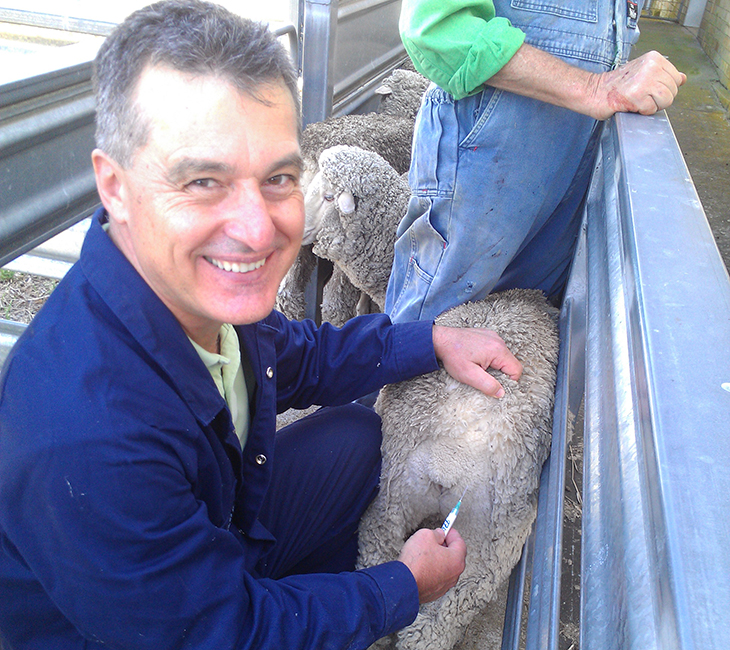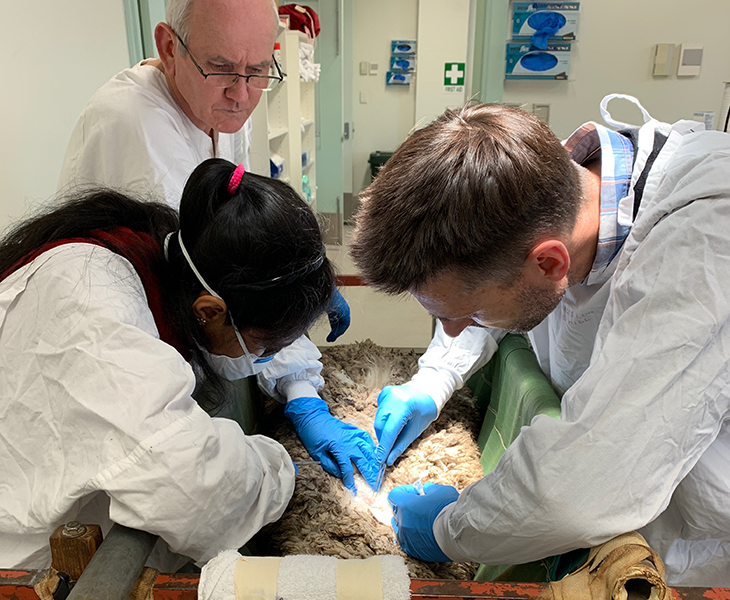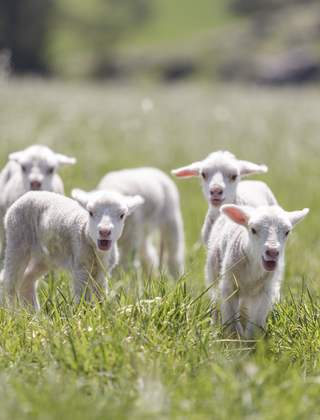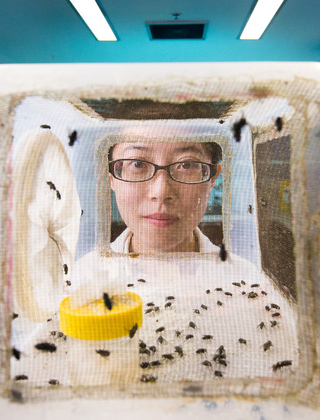Flystrike Vaccine Research Update

AWI is now one year into a major four-year preliminary research project to help develop a commercial vaccine that will protect sheep right across Australia from the Australian sheep blowfly. This $2.5 million collaborative project has achieved much in its first year.
CSIRO scientist Tony Vuocolo vaccinating sheep with prototype flystrike vaccines.
AWI is now one year into a major four-year preliminary research project to help develop a commercial vaccine that will protect sheep right across Australia from the Australian sheep blowfly. This $2.5 million collaborative project has achieved much in its first year.
Here, project leaders Tony Vuocolo (CSIRO) and Trent Perry (University of Melbourne) provide woolgrowers with updates on their respective areas of research.
CSIRO RESEARCH UPDATE
KEY POINTS
- CSIRO researchers have identified key proteins in blowfly maggots that are important for their growth and development.
- The team has developed and tested prototype flystrike vaccines that help the sheep’s immune system build a defence mechanism (antibodies) that will target and destroy these proteins.
- However, extracting natural larval protein from actual flies for the vaccine is prohibitively expensive commercially, so the team is looking at ways to develop an alternative and cheaper way to synthesise them.
During the past 12 months, CSIRO has been advancing the development of a flystrike vaccine by producing and testing an initial subset of prototype trial vaccines. Results from these trials are helping inform what needs to be done next in producing a viable and affordable flystrike vaccine for the sheep industry.
CSIRO has identified key proteins in blowfly larvae (maggots) that are important for their growth and development. The vaccine, when given to sheep, causes the sheep’s immune system to build a defence system in the blood, using weapons called antibodies that will target these key larval proteins. The antibodies react against the larvae when they try to feed on sheep by targeting and interfering with these proteins, resulting in stunted or dead blowfly larvae.
The research initially confirmed that isolating these proteins directly from larvae and using them in a vaccine was highly effective in compromising larval growth and viability. Using this information in combination with the sheep blowfly genome sequence (an outcome from another AWI-funded University of Melbourne project) has allowed the expansion and identification of additional protein-encoding genes that may be used in a vaccine.
It will be prohibitively expensive and require a lot of flies to use the actual proteins extracted from flies themselves. This means we ideally need to develop an alternative cheaper way to synthesise them. However, to generate an effective immune response, the ideal protein antigen(s) for the vaccine must closely resemble the characteristics of the natural larval protein. To do this, antigens are being produced in specialised insect cell systems in the laboratory; in addition, CSIRO is also exploring alternative ways to manufacture key protein associated structures that may be used in a vaccine.
Eight candidate antigens are being trialled currently in prototype vaccines with an additional six in production for testing in the coming several months. The current trials have indicated that special structures associated with these proteins are critical in helping produce an effective immune response that will deleteriously affect larval growth. Ensuring we can retain these structures is the key challenge in producing these complex synthetic antigens.
The next 12 months of research will determine the directions that need to be undertaken to develop an effective flystrike vaccine. Developing a vaccine is difficult but, if successful, will have a huge beneficial impact on the sheep industry. An annual vaccination to help protect sheep from flystrike is the holy grail in flystrike control and remains the key aim of this CSIRO team.
UNIVERSITY OF MELBOURNE RESEARCH UPDATE

University of Melbourne PhD student Gothami Welikadage and scientists Vern Bowles and Trent Perry collecting blowfly larvae from an implanted sheep during their in vivo implant trial.
KEY POINTS
- The University of Melbourne researchers have collected hundreds of blowflies from right across Australia and are studying them to identify the regions that flies are moving between and how they adapt to their environment. This information will help inform pest management strategies, such as how to best contain insecticide resistance if it arises.
- Working with CSIRO, the researchers are examining the protein sequence of current vaccine candidate genes to help ensure that the proteins they are targeting are the same in blowfly populations across Australia.
- Research to identify blowfly proteins that are being excreted during flystrike initiation and find out more about how sheep respond to the infections will assist with vaccine development.
2019 was a big year for the team of researchers at the University of Melbourne (UOM) who have been focused on collecting, identifying and characterising blowfly samples from all across Australia as well as looking at the molecular processes these parasites use to survive on sheep. Blowfly samples were obtained from January to March 2019 from locations in Victoria, Tasmania, NSW and Queensland. Hundreds of flies were collected, not only by the team, but also thanks to a number of woolgrowers and agronomists in sheep growing areas that volunteered their time and properties, for which we are very grateful.
The fly samples have since been genotyped using a technique that provides information on thousands of markers distributed throughout the fly’s genome and this has allowed us to begin building a model of the Australian sheep blowfly population structure in this country. This model, comprising the data from sampling across all years of the project, will allow us to determine how flies are moving around the country.
From our initial sampling, we have been able to use these markers to identify regions that flies are moving between as well as genes in the blowfly genome that may be helping the flies adapt to their environment. As we gather more information about fly migration patterns, this will help inform pest management strategies, such as how to best contain insecticide resistance outbreaks and allow the rapid identification of the origin of flies that are resistant to different chemicals. It is also valuable for evaluating the potential for genetic control or sterile insect release programs as possible future control strategies. We are also extracting information about the blowfly genes that are rapidly evolving as this should provide important information that can help support the selection of vaccine candidates which are critically involved in strike initiation.
Working with CSIRO, we have examined the protein sequence of current vaccine candidate genes and will continue to update CSIRO with sequence data from newly collected blowfly samples as it comes to hand. This information will help ensure that the proteins they are targeting are the same in blowfly populations across Australia and support their attempt to make a vaccine that should be effective across all of Australia.
Another area of the project that we at UOM have been busy with, is a study that aims to understand how flies establish a strike, particularly what proteins are critical in the early stages, just prior to and during the initiation of a strike. We have conducted an in vivo implant trial where sheep were infested with blowfly eggs, and then we collected samples from both maggots and the sheep as the infestation was just being initiated. This work has identified hundreds of fly proteins that are being excreted during strike initiation. We are excited to continue analysing the data in 2020 for proteins that have the potential to be new vaccine candidates and finding out more about how sheep respond to the infections which will assist with vaccine development.
A large component of the second year of the project involves the 2019/20 blowfly collection. We have loved travelling across the country meeting woolgrowers and collecting flies, and appreciate all the mail we have been receiving from our amazing woolgrower and agronomist volunteers. We are working hard to obtain a wider range of blowfly samples to improve the accuracy of our model. Trips by Dr Clare Anstead to deliver collection kits around Western Australia and South Australia added many sites to our study, assisted by woolgrowers in those states.
Hundreds of flies from across the country will be identified and data from these integrated to help build our blowfly population models over the next 12 months. There is also a lot more work needed to understand the way sheep respond to strike and the battle between the maggots and sheep defence mechanisms. We will be delving further into this interaction over the course of this year using more of the samples that were collected during the in vivo implant trial.
Our bioinformatician and newest team member, Dr Shilpa Kapoor, has had her hands full working on the super computers at UOM to analyse the data from our proteomics and genomics work. We will continue working closely with CSIRO, using these results to help inform the process of selecting and developing the optimal vaccine candidates.
This article appeared in the March 2020 edition of AWI’s Beyond the Bale magazine. Reproduction of the article is encouraged, however prior permission must be obtained from the Editor.















